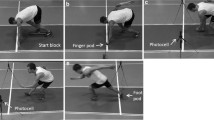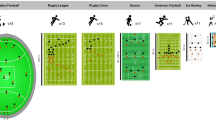Abstract
One of the most important jobs of dance teacher is to detect and estimate the performances of the students during their practices, including confirming the completion of the moves in and out of class as well as evaluating the performance . However, it would be a heavy burden for teachers who do it by themselves, and traditional assist of video techniques is quite expensive and inconvenient for ordinary learners. Therefore, in this paper, we apply sensors within the smart phone to follow the performance of dance trainers and estimate the correctness of motion gesture and rhythm management by measuring the similarity between the motion data of trainers and the standard data with a dynamic time warping based algorithm. And we propose an automatic grading system to assess users’ performances, including the comprehensive evaluation grade as well as the rhythm situation in each part. We apply our solution in the real world practice and compare its results with those that given by experts. According to the results of our experiments, this scheme is able to judge the dancing practice quite accurately and is accepted and confirmed by teachers and experts in dance field. Hopefully, it will be extended to other sports fields as well, such as aerobics and yoga.










Similar content being viewed by others
References
Duarte R, Araújo D, Fernandes O et al (2010) Capturing complex human behaviors in representative sports contexts with a single camera. Medicina (Kaunas) 46(6):408–414
Stensrud S, Myklebust G, Kristianslund E et al (2011) Correlation between two-dimensional video analysis and subjective assessment in evaluating knee control among elite female team handball players. Br J Sports Med 45(7):589–595
Barris Sian; Button Chris (2008) A review of vision-based motion analysis in sport. Sports Med 38(12):1025
Wyon MA, Twitchett E, Angioi M, Clarke F, Metsios G, Koutedakis Y (2011) Time motion and video analysis of classical ballet and contemporary dance performance. Int J Sports Med 32(11):851
Kim T, Park SI, Shin SY (2003) Rhythmic-motion synthesis based on motion-beat analysis. ACM Trans Graph (TOG) 22(3):392–401
Graf H, Yoon SM, Malerczyk C (2010) Real-time 3D reconstruction and pose estimation for human motion analysis. In: 17th IEEE international conference on image processing (ICIP), pp 3981–3984
Yungchien Chu, Jon Akins, Mita Lovalekar, Scott Tashman, Scott Lephart, Timothy Sell (2012) Validation of a video-based motion analysis technique in 3-D dynamic scapular kinematic measurements. J Biomech 45(14):p2462
Sigal L, Balan AO, Black MJ (2010) Humaneva: Synchronized video and motion capture dataset and baseline algorithm for evaluation of articulated human motion. Int J Comput Vision 87(1–2):4–27
Harms H, Amft O, Winkler R et al (2010) Ethos: miniature orientation sensor for wearable human motion analysis. Sensors, 2010 IEEE, pp 1037–1042
Strohrmann C, Harms H, Tröster G et al (2011) Out of the lab and into the woods: kinematic analysis in running using wearable sensors. In: Proceedings of the 13th international conference on ubiquitous computing. ACM, pp 119–122
Yu W, Yan H, Guo J, Bie R (2013) Patient’s motion recognition based on SOM-Decision Tree. In: Proceedings of the 8th international conference on wireless algorithms, systems, and applications, pp 252–264
Yang J (2009) Toward physical activity diary: motion recognition using simple acceleration features with mobile phones. In: Proceedings of the 1st international workshop on interactive multimedia for consumer electronics. ACM, pp 1–10
Kurdthongmee W (2012) A self organizing map based motion classifier with an extension to fall detection problem and its implementation on a Smartphone. Applications of self-organizing maps, pp 161–179
Lynch A, Majeed B, O’Flynn B et al (2005) A wireless inertial measurement system (WIMS) for an interactive dance environment. J Phys Conf Ser 15(1):95–101
Ghasemzadeh H, Jafari R (2011) Physical movement monitoring using body sensor networks: a phonological approach to construct spatial decision trees. IEEE Trans Ind Inf 7(1):66–77
Essid S, Alexiadis D, Tournemenne R et al (2012) An advanced virtual dance performance evaluator. In: 2012 IEEE international conference on acoustics, speech and signal processing (ICASSP), pp 2269–2272
Zappi P, Lombriser C, Stiefmeier T et al (2008) Activity recognition from on-body sensors: accuracy-power trade-off by dynamic sensor selection. Wireless sensor networks. Springer, Berlin, pp 17–33
Chunhao Wu, Tseng Yuchee (2011) Data compression by temporal and spatial correlations in a body-area sensor network: a case study in pilates motion recognition. IEEE Trans Mob Comput 10(10):1459–1472
Ghasemzadeh H, Loseu V, Guenterberg E et al (2009) Sport training using body sensor networks: A statistical approach to measure wrist rotation for golf swing. In: Proceedings of the fourth international conference on body area networks. ICST (Institute for Computer Sciences, Social-Informatics and Telecommunications Engineering)
Ghasemzadeh H, Jafari R (2011) Coordination analysis of human movements with body sensor networks: a signal processing model to evaluate baseball swings. IEEE Sens J 11(3):603–610
Bevilacqua F, Zamborlin B, Sypniewski A et al (2010) Continuous realtime gesture following and recognition. Gesture in embodied communication and human–computer interaction. Springer, Berlin, pp 73–84
Zappi P, Lombriser C, Stiefmeier T et al (2008) Activity recognition from on-body sensors: accuracy-power trade-off by dynamic sensor selection. Wireless Sensor Networks. Springer, Berlin, pp 17–33
Berndt DJ, Clifford J (1994) Using dynamic time warping to find patterns in time series. KDD Workshop 10(16):359–370
Liu J, Zhong L, Wickramasuriya J et al (2009) uWave: accelerometer-based personalized gesture recognition and its applications. Pervasive Mobile Comput 5(6):657–675
Akl A, Valaee S (2010) Accelerometer-based gesture recognition via dynamic-time warping, affinity propagation, and compressive sensing. In: 2010 IEEE international conference on acoustics speech and signal processing (ICASSP), pp 2270–2273
Shiratori T, Nakazawa A, Ikeuchi K (2004) Detecting dance motion structure through music analysis. In: proceedings of the sixth IEEE international conference on automatic face and gesture recognition, pp 857–862
Wattanapong Kurdthongmee (2012) A self organizing map based motion classifier with an extension to fall detection problem and its implementation on a Smartphone. Applications of self-organizing maps
Sakoe H, Chiba S (1978) Dynamic programming algorithm optimization for spoken word recognition. IEEE Trans Acoust Speech Signal Process 26(1):43–49
Sakoe H, Chiba S (1971) A dynamic programming approach to continuous speech recognition. Proc Seventh Int Congr Acoust 3:65–69
Fukunaga K (1990) Introduction to statistical pattern recognition. Academic Press, San Diego
de Bruine Bruin W, Keren G (2003) Order effects in sequentially judged options due to the direction of comparison. Organ Behav Hum Decis Process 92(1):91–101
de Bruine Bruin W (2006) Save the last dance II: unwanted serial position effects in figure skating judgments. Acta Psychol 123(3):299–311
Acknowledgments
This research is sponsored by National Natural Science Foundation of China (61003225, 61171014,61272475,61371185) and the Fundamental Research Funds for the Central Universities (2013NT57), and the youth talents project of Beijing (YETP1711) and by SRF for ROCS, SEM.
Author information
Authors and Affiliations
Corresponding author
Rights and permissions
About this article
Cite this article
Wei, Y., Yan, H., Bie, R. et al. Performance monitoring and evaluation in dance teaching with mobile sensing technology. Pers Ubiquit Comput 18, 1929–1939 (2014). https://doi.org/10.1007/s00779-014-0799-7
Received:
Accepted:
Published:
Issue Date:
DOI: https://doi.org/10.1007/s00779-014-0799-7




